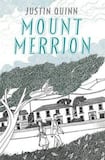
Mount Merrion has always regarded itself as a somewhat special suburb of Dublin. Its leafy, low-density layout and to an extent the mindset of its citizenry reflect the languor and grandeur of Viscount Fitzwilliam’s 1711 Mount Merrion House and lands, on which the modern suburb is laid out.
That history is very much alive, and to this day the area is known to insiders as the demesne.
The avenue to the old house ran magnificently from the coast road at Blackrock right up to The Rise, where St Thérèse’s Church and the community centre now stand. That avenue is nowadays transected by the N11, which acts as a boundary dividing the original Fitzwilliam lands.
Particularly from the 1930s onwards, Mount Merrion became home to an aspiring cadre of society. The novelist Robert Cremins was part of Mount Merrion’s 1960s-born generation of creativity, and now his peer Justin Quinn, the poet and critic, has, in his debut novel, imaginatively constructed a chronicle of four generations of a local family, the Boyles.
He does so in seven chapters set from 1959 to 2002, snapshots of the Boyles as their destiny is played out.
Quinn’s plotting moves the story forward in a satisfying rhythm while allowing us ample time to imbibe the flavour of each decade.
Ambition and aspiration loom large in this book, as they do for so many families of the area and times. Hanging over such concerns is the question of what is left when ambition and aspiration are played out. The country boy made good is an early theme, as Quinn's characters find themselves shaking the village dust from their shoes.
Pecking order
Awareness of one's place in the somewhat fossilised social pecking order is made to give way a little to a more urbane, suburban meritocracy. Yet in Quinn's tale the lure of the rural home place is not so easily escaped. Europe also holds an early and ongoing promise for the Boyles, whose mindset (like that of Quinn himself, based in Prague) is turned outwards to a wider world.
The novel centres on Declan Boyle, born in 1936 and, in not untypical Mount Merrion fashion, a civil servant (initially at least). He begins his career in 1959, motivated by a sense of patriotism and a wish to make Ireland a better place. In having Boyle forge his own destiny in defiance of parental authority, Quinn identifies an intergenerational fault line of some relevance to the times and places of which he writes.
Boyle’s wife, Sinéad Grogan, is from Foxrock, a nearby suburban village seen as of an older vintage in the south Dublin pecking order but nowadays united politically with Mount Merrion at county-council level in the more demotically entitled Stillorgan Ward.
Quinn beautifully records the uncertainties and fragilities of young love, and how relationships can develop over the long span of time that he allows his characters. Sinéad too has her power struggles with husbandly authority, and Quinn switches between their perspectives with an empathetic ease.
Incongruously, given the title, Quinn sets most of the action on Mount Merrion Avenue, which is part not of Mount Merrion but of Blackrock. Perhaps this little bit of poetic licence can be understood, as the author is a Mount Merrion Avenue native. But to those, like this reviewer, who grew up in Mount Merrion proper, such geographical liberties might slightly challenge the sense of place invoked by the novel’s title.
By way of possible further challenge, the Boyles initially settle in Dundrum, some distance from Mount Merrion, and succeeding generations pitch up in Terenure. The only conclusion one can come to is that Mount Merrion, like “Dublin 4”, is less a precise physical location and more a state of mind.
Quinn has a fine eye for the small gestures and attitudes that convert humdrum existence into something more heroic: the tender reaching out to another in empathy and affection, the sufferings bravely borne, the extraction of the potential for meaning latent in difficult situations.
If the best novels illuminate the human condition and teach us a little about how to live, Quinn has contributed something of excellence on that score alone.
First-time novelist
While Quinn's previous publications were works of poetry and criticism, his writing as a first-time novelist is attractive and powerful, and his poetic gifts are deployed in aid of rather than as a distraction from his storytelling.
Multigenerational novels can be a challenge for any writer. One thinks of Wuthering Heights and a certain crunching of the gears as the action moves to the next generation down. But Quinn has made a great story and created a work that is both beautifully written and a well-paced page-turner.
His south Dublin characters encapsulate a great deal of the spirit of the area but also become suburban Everymen who will speak to a wider audience about the sorrows and pleasures of family, of ambition and of attachment to a landscape and place.
Richard Humphreys is a senior counsel, Labour councillor and author of Countdown to Unity (Irish Academic Press).






